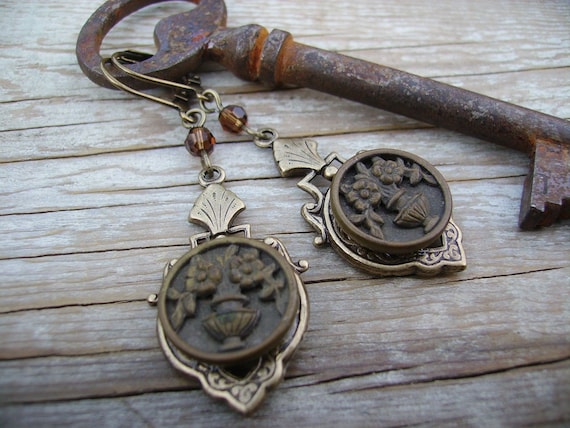 |
| Victorian Buttons & Necklace |
Buttons were invented in the Bronze Age. Their earliest use in Ancient Greece, the Indus Valley and China was as ornament rather than fastener.
 |
| 15th Century Button from the UK |
Functional buttons, buttons as technology, appeared in Medieval Europe along with closer fitting garments of the 13th century on. Though the hook and eye closure was in use by the 14th century in England, in the mid 19th century steel hook closures enabled tighter lacing.
 |
| 1850-1900 Buttons |
Designs of the early Victorian era reflected the romantic notions of the
young queen’s courtship and marriage and a fascination with natural history.
Love tokens, travel charms and other symbol-laden, sentiment-infused
jewelry was popular from 1830 through the end of the 19th century.
Production
methods in the mid 1800s popularized the use of steel picture buttons on
women’s and children’s clothing from the 1860s into the Edwardian era.
Victorian pictures buttons, often with multiple layers, featured
detailed scenes from Classical art and European fairytales.
The mid 18th century excavations at Pompeii and Herculaneum also influenced a resurgence of iconic Greek and Roman
imagery on 19th century buttons. Classical heroes, such as Hector, as well as scenes from popular operas and fables adorned buttons.
Natural and romantic designs - botanical scenes, animals were common. Most buttons were made of steel, brass, mother of pearl, wood, or horn. The patterns and detail can be stunning and intricate.
 With the death of Prince Albert in 1861, Queen Victoria adorned herself
in black Whitby jet mourning jewelry, causing the rest of the nation to do the
same. Jet is a hard, deep black material formed when wood petrifies under pressure in the presence of salt water.
With the death of Prince Albert in 1861, Queen Victoria adorned herself
in black Whitby jet mourning jewelry, causing the rest of the nation to do the
same. Jet is a hard, deep black material formed when wood petrifies under pressure in the presence of salt water.
The premium jet preferred by the Queen came from mines in Yorkshire, but was not affordable to most. Since the petrified wood jet was expensive, black glass buttons came into fashion to fulfill the need for strict rules of mourning attire in Victorian Europe.
One of Queen Victorian and Prince Albert's daughters, Princess Louise is pictured at right wearing a jet necklace and mourning attire after the death of her father.
 |
| Gown with Buttons, 1870-80 |
The mid 18th century excavations at Pompeii and Herculaneum also influenced a resurgence of iconic Greek and Roman
imagery on 19th century buttons. Classical heroes, such as Hector, as well as scenes from popular operas and fables adorned buttons.
Natural and romantic designs - botanical scenes, animals were common. Most buttons were made of steel, brass, mother of pearl, wood, or horn. The patterns and detail can be stunning and intricate.
 With the death of Prince Albert in 1861, Queen Victoria adorned herself
in black Whitby jet mourning jewelry, causing the rest of the nation to do the
same. Jet is a hard, deep black material formed when wood petrifies under pressure in the presence of salt water.
With the death of Prince Albert in 1861, Queen Victoria adorned herself
in black Whitby jet mourning jewelry, causing the rest of the nation to do the
same. Jet is a hard, deep black material formed when wood petrifies under pressure in the presence of salt water.The premium jet preferred by the Queen came from mines in Yorkshire, but was not affordable to most. Since the petrified wood jet was expensive, black glass buttons came into fashion to fulfill the need for strict rules of mourning attire in Victorian Europe.
One of Queen Victorian and Prince Albert's daughters, Princess Louise is pictured at right wearing a jet necklace and mourning attire after the death of her father.
The 1860s and 1870s was also the time of the Civil War in the United States. It was a time when most of the world was in revolution, tumult and mourning. Germany, Italy, France, Prussia, and other countries were formed and torn asunder in decades of upheaval as the modern world was born. As a result of widespread grief suffered by Royal family and families the world over, keepsake charms, lockets and other sentimental expressions of love and memory flourished throughout the Victorian era into the early 20th century.
 |
| Compass Rose Design Earrings |
Visit the Compass Rose Design website for upcoming events and discounts
Learn More about the history behind my designs on Pinterest
Learn More about the history behind my designs on Pinterest

No comments:
Post a Comment